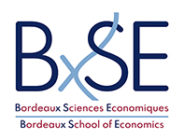Doctorant en Cotutelle (University of Insubria)
BSE
Université de Bordeaux
Avenue Léon Duguit, Bât. H2
33608 PESSAC CEDEX
Bureau H2-310
cecilia.maronero@u-bordeaux.fr
or
cecilia.maronero@gmail.com
Innovation, Intellectual Property Rights and Non-Practicing Entities (NPEs) in the European Patent Market
Innovation, Droits de Propriété Intellectuelle et Non-Practicing Entities (NPEs) sur le Marché des Brevets Européens
Prof. Valerio Sterzi (BSE, Université de Bordeaux)
Prof. Andrea Vezzulli (University of Insubria, Varese, Italy)
Résumé EN:
Patents are a form of intellectual property rights (IPRs) that are particularly relevant to promoting innovative activities. A patent grants to its owner a temporary exclusive right over inventions that are new, involve an inventive step and are susceptible of industrial application. Relying on this right, inventors can protect their ideas from imitation and gain an economic return from their past investments in research and development (R&D). However, the use of patents has undergone a significant transformation, extending beyond the traditional purpose of rewarding innovative efforts, especially in the field of Information and Communication Technology (ICT). Moreover, over the past three decades, the sharp increase in the number of granted patents and the unprecedented flourishing of patent trading have paved the way for new intermediaries in the market for technology. Non-practicing entities (NPEs)—firms that do not use their patents in a traditional manufacturing sense, but primarily engage in licensing and enforcement—have emerged as prominent actors on the patent market. Due to their non-manufacturing status, NPEs have unique advantages over operating companies. While NPEs have been extensively analyzed in the US patent market since their emergence in the early 2000s, it is only recently that researchers have started to investigate their presence in the European technology market.
This thesis aims to address these research gaps by examining the NPE phenomenon in the European patent marketplace. First, we extensively explore and analyze the literature on NPE business models by adopting a novel bibliometric approach guided by the Preferred Reporting Items for Systematic Review and Meta-Analysis (PRISMA) protocol for systematic literature reviews. In addition, we will integrate three relevant NPE business models case studies. Second, we empirically investigate the presence of NPEs in the European patent market through a brand- new dataset of NPE patent filings and acquisitions at the European Patent Office (EPO). Furthermore, we develop an original taxonomy, thus categorizing NPEs into three business models: “Litigation,” “Portfolio” and “Technology” NPEs. Finally, we empirically explore the interplay between the quality characteristics of the asserted patent and the propensity of NPEs to choose specific European jurisdictions where to initiate litigation (forum shopping).
Résumé FR:
Les brevets sont une forme de droits de propriété intellectuelle (PI) particulièrement pertinente pour promouvoir les activités innovantes. Un brevet accorde à son propriétaire un droit exclusif temporaire sur des inventions qui sont nouvelles, qui impliquent une étape inventive et qui sont susceptibles d’une application industrielle. En s’appuyant sur ce droit, les inventeurs peuvent protéger leurs idées contre l’imitation et obtenir un retour économique sur leurs investissements en recherche et développement (R&D). Cependant, l’utilisation des brevets a connu une transformation significative, s’étendant bien au-delà de l’objectif traditionnel de récompenser les efforts innovants, particulièrement dans le domaine des technologies de l’information et de la communication (ICT). De plus, au cours des trois dernières décennies, l’augmentation marquée du nombre de brevets accordés et l’essor sans précédent du commerce des brevets ont ouvert la voie à de nouveaux intermédiaires sur le marché des technologies. Les Non-Practicing Entities (NPEs)—des entreprises qui n’utilisent pas leurs brevets de manière traditionnelle dans la fabrication, mais qui se consacrent principalement à la concession de licences et à l’application—ont émergé en tant qu’acteurs importants sur le marché des brevets. En raison de leur statut de non-producteurs, les NPEs bénéficient des avantages uniques par rapport aux entreprises productrices. Alors que les NPEs ont été largement analysées sur le marché des brevets aux États-Unis depuis leur apparition au début des années 2000, ce n’est que récemment que les chercheurs ont commencé à étudier leur présence sur le marché technologique européen.
Cette thèse vise à combler ces lacunes de recherche en examinant le phénomène des NPEs sur le marché des brevets européens. D’abord, nous explorons et analysons de manière approfondie la littérature sur les modèles économiques des NPEs en adoptant une approche bibliométrique guidée par le protocole Preferred Reporting Items for Systematic Review and Meta-Analysis (PRISMA) pour les revues systématiques de littérature. De plus, nous intégrerons trois études de cas sur les modèles économiques des NPEs. Ensuite, nous étudions empiriquement la présence des NPEs sur le marché des brevets européens grâce à un nouveau jeu de données crée pour analyser les demandes de brevet et les acquisitions de NPEs à l’Office européen des brevets (OEB). Nous élaborons aussi une taxonomie originale, classant ainsi les NPEs en trois modèles économiques : “Litigation”, “Portfolio” et “Technology”. Enfin, nous explorons empiriquement l’interaction entre les caractéristiques de qualité des brevets revendiqués et la propension des NPEs à choisir des juridictions européennes spécifiques pour engager des poursuites (« forum shopping »).



